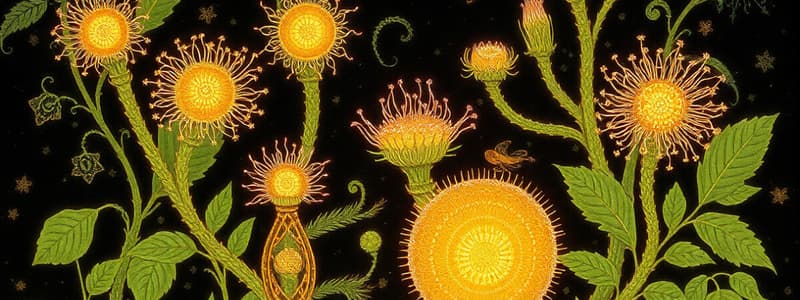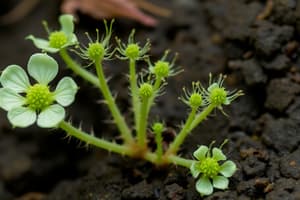Podcast
Questions and Answers
Which evolutionary advantage primarily facilitated plants' transition from aquatic to terrestrial environments?
Which evolutionary advantage primarily facilitated plants' transition from aquatic to terrestrial environments?
- Greater ease of gaseous exchange. (correct)
- Diminished risk of desiccation.
- Reduced exposure to ultraviolet radiation.
- Increased competition for resources.
What primary challenge did plants face in adapting to terrestrial environments, necessitating evolutionary adaptations?
What primary challenge did plants face in adapting to terrestrial environments, necessitating evolutionary adaptations?
- Difficulty in maintaining support. (correct)
- Abundant nutrient supply.
- Excessive water availability.
- Decreased competition for sunlight.
How does the alternation of generations in plants uniquely contribute to their adaptability and survival in diverse environments?
How does the alternation of generations in plants uniquely contribute to their adaptability and survival in diverse environments?
- By eliminating the need for water in fertilization.
- By promoting rapid asexual reproduction.
- Through varying the dominance of haploid and diploid phases. (correct)
- By reducing genetic diversity within populations.
What evolutionary advantage do multicellular, dependent embryos confer upon plants, enhancing their survival rates?
What evolutionary advantage do multicellular, dependent embryos confer upon plants, enhancing their survival rates?
How does the production of walled spores in sporangia contribute to the evolutionary success of plants in terrestrial environments?
How does the production of walled spores in sporangia contribute to the evolutionary success of plants in terrestrial environments?
In what way do multicellular gametangia represent a significant evolutionary innovation for plants adapting to land?
In what way do multicellular gametangia represent a significant evolutionary innovation for plants adapting to land?
What role do apical meristems play in enabling plants to colonize diverse terrestrial habitats effectively?
What role do apical meristems play in enabling plants to colonize diverse terrestrial habitats effectively?
Considering the evolutionary timeline, what key adaptation marks the divergence of vascular plants from their non-vascular ancestors?
Considering the evolutionary timeline, what key adaptation marks the divergence of vascular plants from their non-vascular ancestors?
How did the evolution of seeds represent a critical innovation, enabling plants to thrive in a broader range of terrestrial environments?
How did the evolution of seeds represent a critical innovation, enabling plants to thrive in a broader range of terrestrial environments?
What ecological role do algae play in aquatic ecosystems, that underscores their significance in the evolution of plants?
What ecological role do algae play in aquatic ecosystems, that underscores their significance in the evolution of plants?
How might the absence of vascular tissues in bryophytes constrain their ecological distribution and physical structure?
How might the absence of vascular tissues in bryophytes constrain their ecological distribution and physical structure?
What evolutionary pressure might have favored the development of desiccation-resistant spores in early terrestrial plants?
What evolutionary pressure might have favored the development of desiccation-resistant spores in early terrestrial plants?
How does the dominance of the gametophyte generation in bryophytes influence their reproductive strategies and habitat preferences?
How does the dominance of the gametophyte generation in bryophytes influence their reproductive strategies and habitat preferences?
What selective advantage did the evolution of a sporophyte-dominant life cycle confer upon early vascular plants?
What selective advantage did the evolution of a sporophyte-dominant life cycle confer upon early vascular plants?
Considering the evolutionary progression, how does the emergence of true leaves and roots in pteridophytes represent an advancement over bryophytes?
Considering the evolutionary progression, how does the emergence of true leaves and roots in pteridophytes represent an advancement over bryophytes?
In what crucial way does the presence of xylem and phloem tissues in pteridophytes contribute to their ecological success compared to bryophytes?
In what crucial way does the presence of xylem and phloem tissues in pteridophytes contribute to their ecological success compared to bryophytes?
Which of the following best explains the ecological significance of bryophytes in terrestrial ecosystems?
Which of the following best explains the ecological significance of bryophytes in terrestrial ecosystems?
How does the process of alternation of generations in land plants differ significantly from that in their algal ancestors?
How does the process of alternation of generations in land plants differ significantly from that in their algal ancestors?
Which characteristic of early streptophyte algae is considered most critical in their evolutionary transition to land plants?
Which characteristic of early streptophyte algae is considered most critical in their evolutionary transition to land plants?
What innovation allowed vascular plants to grow tall, outcompeting non-vascular plants for sunlight?
What innovation allowed vascular plants to grow tall, outcompeting non-vascular plants for sunlight?
The success of seed plants in diverse terrestrial habitats depends largely on which adaptation?
The success of seed plants in diverse terrestrial habitats depends largely on which adaptation?
In comparing algae and land plants, what photosynthetic pigment is uniquely present in certain groups of algae, influencing their ability to absorb light at different depths?
In comparing algae and land plants, what photosynthetic pigment is uniquely present in certain groups of algae, influencing their ability to absorb light at different depths?
How did the transition of plants to land influence global biogeochemical cycles?
How did the transition of plants to land influence global biogeochemical cycles?
Which symbiotic relationship was crucial for the early colonization of land by plants by enhancing nutrient uptake?
Which symbiotic relationship was crucial for the early colonization of land by plants by enhancing nutrient uptake?
How does the ecological role of sphagnum mosses contribute to carbon sequestration in boreal and arctic ecosystems?
How does the ecological role of sphagnum mosses contribute to carbon sequestration in boreal and arctic ecosystems?
What evolutionary constraint do flagellated sperm impose on the reproductive strategies of bryophytes and pteridophytes?
What evolutionary constraint do flagellated sperm impose on the reproductive strategies of bryophytes and pteridophytes?
Which adaptation in seed plants has most directly contributed to their ability to colonize drier habitats?
Which adaptation in seed plants has most directly contributed to their ability to colonize drier habitats?
How might the secondary compounds produced by plants have influenced the evolution of herbivorous insects?
How might the secondary compounds produced by plants have influenced the evolution of herbivorous insects?
The evolution of plant height in vascular plants is a response to selection pressure, which of the following describes this pressure best?
The evolution of plant height in vascular plants is a response to selection pressure, which of the following describes this pressure best?
In the life cycle of land plants, what evolutionary advantage does the diploid sporophyte stage offer over the haploid gametophyte stage in terms of dealing with mutations?
In the life cycle of land plants, what evolutionary advantage does the diploid sporophyte stage offer over the haploid gametophyte stage in terms of dealing with mutations?
What is a significant abiotic challenge that drove the evolution of drought tolerance in plants?
What is a significant abiotic challenge that drove the evolution of drought tolerance in plants?
What alteration in the plant life cycle is a result of the heterosporous condition?
What alteration in the plant life cycle is a result of the heterosporous condition?
What role do specialized metabolic pathways play in enhancing the ecological adaptation of plants to diverse environments?
What role do specialized metabolic pathways play in enhancing the ecological adaptation of plants to diverse environments?
What is the relationship between climate change and the geographical distribution of plant species?
What is the relationship between climate change and the geographical distribution of plant species?
How might the loss of genetic diversity within plant species affect their ability to adapt to environmental changes caused by human activities?
How might the loss of genetic diversity within plant species affect their ability to adapt to environmental changes caused by human activities?
What is the role of plant-animal interactions in the coevolutionary history of terrestrial ecosystems?
What is the role of plant-animal interactions in the coevolutionary history of terrestrial ecosystems?
What is the impact of land plants on Earth's climate?
What is the impact of land plants on Earth's climate?
Flashcards
Plant Origin
Plant Origin
The hypothesis that plants evolved from algae.
Benefits of Land
Benefits of Land
Gaseous exchange, increased light, and richer soil nutrients.
Land Challenges
Land Challenges
Drying out and physical support challenges.
Alternation of Generations
Alternation of Generations
Signup and view all the flashcards
Multicellular Embryos
Multicellular Embryos
Signup and view all the flashcards
Protected Spores
Protected Spores
Signup and view all the flashcards
Multicellular Gametangia
Multicellular Gametangia
Signup and view all the flashcards
Apical Meristems
Apical Meristems
Signup and view all the flashcards
Phytoplankton
Phytoplankton
Signup and view all the flashcards
Phytobenthos
Phytobenthos
Signup and view all the flashcards
Bryophytes
Bryophytes
Signup and view all the flashcards
Bryophyte Importance
Bryophyte Importance
Signup and view all the flashcards
Bryophyte traits
Bryophyte traits
Signup and view all the flashcards
Pteridophytes
Pteridophytes
Signup and view all the flashcards
Xylem
Xylem
Signup and view all the flashcards
Phloem
Phloem
Signup and view all the flashcards
Pteridophyte advantage
Pteridophyte advantage
Signup and view all the flashcards
Study Notes
Origin of Plants
- It is believed that plants came from algae, which are multicellular, eukaryotic, and autotrophic.
Advantages and Disadvantages of the Terrestrial Environment
- Terrestrial environments offer advantages such as ease of gas exchange, greater light availability, and nutrient-rich soil.
- The disadvantages are desiccation and difficulty of support.
Evolutionary Origin
- The ancestral alga evolved into several groups of algae, including red algae, chlorophytes, and charophytes.
- Charophytes and eventually embryophytes (plants) branched out.
Plant Characteristics
- Plants have unique characteristics, including alternation of generations, multicellular dependent embryos, spores coated and produced in sporangium, multicellular gametangia, and apical meristems.
Alternation of Generations
- The alternation of generations has five generalized steps.
- The gametophyte produces haploid gametes by mitosis.
- Two gametes join (fertilization) to form a diploid zygote.
- The zygote develops into a multicellular diploid sporophyte.
- The sporophyte produces unicellular haploid spores by meiosis.
- The spores develop into multicellular haploid gametophytes.
Multicellular Dependent Embryos
- Embryos obtain nutrients from the maternal tissue through placental transfer cells.
Sporangia
- Plants' spores are coated and produced in sporangia
Gametangia
- Plants have multicellular gametangia
- Archegonia hold oospheres
- Antheridia contain spermatozoids.
Apical Meristems
- Apical meristems are found in the roots and stems of plants, driving growth.
Vegetal Evolution
- Land plants originated about 470 million years ago (maa).
- Vascular plants originated approximately 425 maa.
- Seed plants originated around 305 maa
Algae
- Algae can be either phytoplankton or phytobenthos.
- They contain various pigments like chlorophyll, carotenoids, and phycobilins, each with different types and colors to absorb light for photosynthesis.
Plant Evolution
- Land plants emerged from algae and developed adaptations such as protected embryos, vascular tissues, visible reproductive structures, and eventually flowers and fruits.
Bryophytes
- Bryophytes are the first terrestrial plants with gametophyte as the dominant phase.
- Bryophytes are dependent on moisture for reproduction.
- They have economic importance, aiding in soil nitrogenation and atmospheric cooling.
- They feature rhizoids, phyllodes, and cauloids.
- The absence of vascular tissues limits their growth.
Bryophyte Reproduction
- Haploid spores develop into filamentous protonema.
- Protonema produce buds that divide by mitosis into gametophores.
- Sperm must swim through a film of moisture to reach and fertilize the egg.
- This produces a diploid zygote within the archegonium.
- The sporophyte grows from the archegonium and remains nutritionally dependent on the gametophyte.
- Meiosis occurs in the sporangium, releasing haploid spores.
Pteridophytes
- They are the first vascular plants, with a dominant sporophyte phase.
- They can grow taller and their advantages include vascular system for nutrient transport, leading to increased height.
- This also allows for more efficient spore dispersal.
- Water and minerals are transported via xylem which is composed of dead cells.
- Food is transported via pholem which has living cells.
- Epiphytes can grow on other plants.
Pteridophyte Life Cycle
- The sporophyte releases spores, which develop into a bisexual photosynthetic gametophyte.
- The gametophyte produces sperm in antheridia and eggs in archegonia.
- A sperm fertilizes an egg, forming a zygote, which develops into a new sporophyte in the archegonium.
- Sori—clusters of sporangia—release spores.
Studying That Suits You
Use AI to generate personalized quizzes and flashcards to suit your learning preferences.




